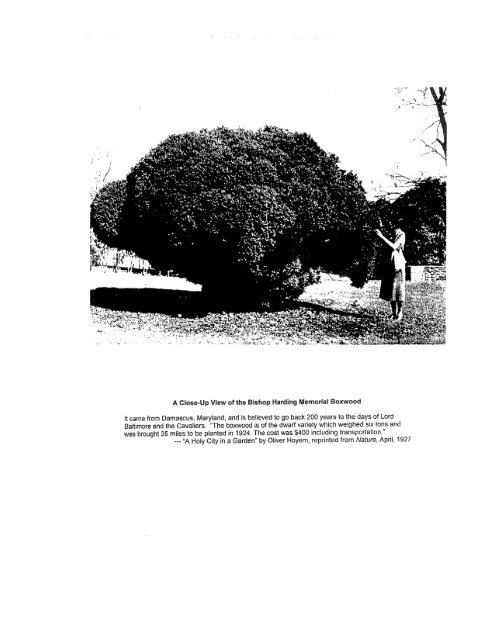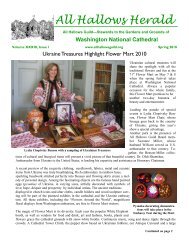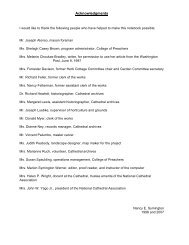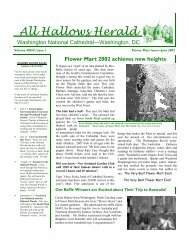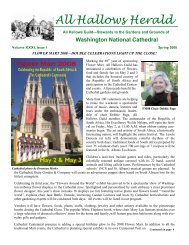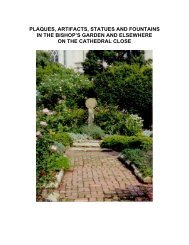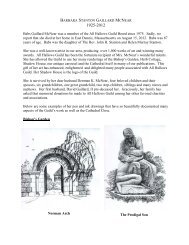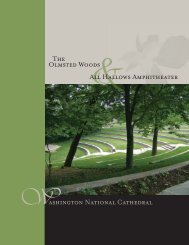Part 2: Bishop's Garden - Hallows Guild
Part 2: Bishop's Garden - Hallows Guild
Part 2: Bishop's Garden - Hallows Guild
You also want an ePaper? Increase the reach of your titles
YUMPU automatically turns print PDFs into web optimized ePapers that Google loves.
A Dominant Note in the Bishop’s <strong>Garden</strong>: The Great PineSeventy feet high, seventy tons in weight, including its twenty foot ball of earth, this great treewas moved over one thousand feet to its present location in the Bishop’s <strong>Garden</strong>: perhaps thelargest evergreen ever successfully transplanted in America. Hundreds of tree lovers throughoutthe country united in an offering to save the life of this noble tree which, due to buildingconstruction, was about to be cut down. This photograph was taken a year after its adventure andshows how it has responded to new conditions with an abundance of wholesome growth. Justbeyond the Great Pine is a superb specimen of old English Boxwood given in 1924 by All <strong>Hallows</strong><strong>Guild</strong> in the memory of Alfred Harding, D.D., LL D., second Bishop of Washington. In the distanceis the Boxwood <strong>Garden</strong>.Cathedral Age, Michaelmas, 1928
Shadow HouseLocation:Description:At the east end of the Bishop’s LawnThe Shadow House is made of Carderock stone from “Red Top,” the summerhome of President Grover Cleveland. Mr. Philip Hubert Frohman designedthe Shadow House or garden house. Mrs. Bratenahl found the stone when“Red Top” was being torn down. The pie-shaped bricks that form the floorcame from “Ellerslie” plantation in southeast Virginia near Petersburg.Samuel Yellin designed the weather vane.Dedication Date: April 27, 1928Donor:The Bishop’s <strong>Guild</strong> gave the Shadow House as their offering to the Bishop’s<strong>Garden</strong>.Shadow House
Inscription:This Shadow HouseWas Erected InThe Bishop’s <strong>Garden</strong>Through the GenerosityOf the Bishop’s <strong>Guild</strong>Under the Leadership ofMrs. Charles Mason WilkesAnno DominiMCMXXXXVIIIMrs. Charles Mason Wilkes was the secretary-treasurer of the Bishop’s <strong>Guild</strong>. Bishop Freemansuggested this inscription. It was to be a brass tablet, designed by Mrs. Bratenahl and executedby Gorham & Company. The tablet was to be placed inside the Shadow House, but it cannot befound.BRASS TABLET IN SHADOW HOUSEDesigned by Florence Bratenahl, executed by Gorham & Co.From a booklet entitled “Historic Trees, Boxwood, Yew, and Stone; Some Unusual Material on aCathedral Hillside,” by Florence Bratenahl, 1932.
Plaque to Bessie Huidekoper FayLocation:Description:In the lower wall at the south end of the Bishop’s <strong>Garden</strong>The plaque is bluestone.Date: May 14, 1980Donor:Inscription:Colonel Reginald Huidekoper established a trust which provided for thememorial to his wife. With his brother, Mr. Frederick Huidekoper, he alsogave the rood screen in the Cathedral in 1939.In Loving Memory ofBessie Huidekoper Fay1889-1973“Mr. Meade Palmer designed the garden spot around a golden chaintree; the tree had been a favorite of Mrs. Huidekoper Fay. The boxwoodwas donated by many persons, including the family.”Cathedral Age, Fall, 1980
Fountain Designed by Mrs. L. Corrin StrongLocation:Description:On the south wall facing Pilgrim Road and the statue of GeorgeWashingtonThe fountain was designed by Mrs. Strong and is made of lead. Theflowers cast on the fountain are: trout lily, may apple, fern, snowdrop,trillium, lily of the valley, twin leaf, iris, and jack-in-the-pulpit.Dedication Date: November 10, 1950There is an old granite millstone below it.Donors:Mrs. L. Corrin Strong and friends of Miss Rosalind Wright
Fountain Designed by Mrs. L. Corrin Strong, ContinuedInscription:Around the upper edge of the fountain is inscribed:In Memoriam to Rosalind Washburn Wright1900 -1948On the face is inscribed:Through the Hands ofSuch As TheseGod SpeaksAnd from Behind Their EyesHe Smiles UponThe EarthThe ProphetMiss Rosalind Wright was a member of the All <strong>Hallows</strong> <strong>Guild</strong> <strong>Garden</strong> Committee and a closefriend of Bishop and Mrs. Angus Dun.Lady Macfarlane Reid, sister of Rosalind Wright, writes: “The fountain was sculpted by Mrs.Strong who presented me with the original model.”-- Letter dated October 8, 1990
Carolingian Font in the HortulusLocation:Description:West of the rose garden, northeast of Shadow House in the HortulusThe font is attributed to the time of Charlemagne and is reported to havecome from the Abbey of St. Julie in the Aisne. The top is marble and thepedestal is of Caen limestone. It was an acquisition from the collection ofGeorge Grey Barnard.Date: 1927Donor:Mrs. Henry Hudson Barton of Philadelphia gave the font in memory ofher husband. When first purchased, “the cost of the great font was farless than its original price to a museum, thanks to George GreyBarnard.”Mrs. Bratenahl, Cathedral Age, Easter 1927
SundialLocation:Description:North of the rose garden in the herb gardenThe 18 th century English bronze sundial sits on a 13 th century Gothiccapital of Caen limestone from a ruined monastery near RheimsCathedral. The capital was acquired from the collection of George GreyBarnard.Date: 1928Donor:Mrs. John H. Gibbons gave the sundial as a memorial to her mother,Mrs. Richard S. Ely.
St. Catherine’s PoolLocation:Description:To the left of the upper perennial borderThe pool is made of Aquia Creek sandstone in the shape of a primitivecross. It was designed by Mrs. Bratenahl.Date: 1929Donor:The Lake Forest <strong>Garden</strong> Club of Illinois
Statue of St. Francis by St. Catherine’s Pool“The statue of St. Francis of Assisi, sculpted by Eleanor Mellon of bronze and accepted by All<strong>Hallows</strong> <strong>Guild</strong>, is three feet tall. It will be placed by the pool in the Bishop’s <strong>Garden</strong>.”Building Committee minutes, June 13, 1961There is no evidence that a statue of St. Francis of Assisi was ever placed by the pool.
Bas Relief of St. Catherine and Other FiguresLocation:Description:In the wall above St. Catherine’s PoolThe 15 th century granite bas relief depicts St. Catherine holding thewheel on the far left and three other figures.Date: 1937“The male figure on the right-hand side of the relief with St. Catherineholds, like her, a palm, which characterizes him as a martyr.”Julian Chapuis, Assistant Curator, The Cloistersand Metropolitan Museum of ArtThe bas relief was acquired from the collection of George Grey Barnard.Donor:Mrs. Robert Low Bacon gave the bas relief in memory of her sister,Mrs. Henry Marquand.
Wayside CrossLocation:Description:Near St. Catherine’s Pool in the upper perennial borderThe Celtic cross, also called a round-headed or wheel cross, is made ofsandstone, dating from early Christian pilgrimages.Date: 1928Donor:Inscription:George Grey BarnardIHS, the sacred monogram of Christ, is in the middle of the cross. (InGreek it is IHSOUS, meaning Jesus.) Around the outer edge in Latin isinscribed:Our soul is humbled even unto the dustPsalms 44:25“Often erected in ancient times at the crossroads or as boundarymarkers or by a lonely wayside for a moment of rest and devotion, thesecrosses were welcomed by pilgrims as guards and guides along a way ofpeace to the church.”Mrs. Bratenahl, Cathedral Age, Easter 1928
Bas Relief of Kneeling FigureLocation:Description:In the wall behind the perennial garden, to the right of St. Catherine’sPoolThe 15 th century kneeling figure is made of granite. It was an acquisitionfrom the collection of George Grey Barnard.Date: May 22, 1931Donor:The Junior <strong>Garden</strong>ers of Philadelphia gave the bas relief in memory ofEleanor Pepper Newbold, their first president.
Bas Relief of Four Figures on the WallAbove the Perennial <strong>Garden</strong>Location:Description:To the right of St. Catherine’s PoolThe bas relief is made of granite and was acquired from the collection ofGeorge Grey Barnard. Mrs. Bratenahl’s description of the bas relief:“Saints, martyrs, heroes – this being the last of a number of museumpieces acquired from the noted Gothic collection of George GreyBarnard.”“Three figures are depicted in monastic dress and must therefore bemembers of a religious order.”Julien Chapuis, Assistant Curator, The Cloistersand the Metropolitan Museum of ArtDate:Donor:1931 or laterThe Noanett <strong>Garden</strong> Club of Massachusetts
Plaque to Mrs. L. Corrin StrongLocation:Description:On the wall above the perennial garden to the left of the Medlar (Mespilusgermanica) treeThe plaque is made of bluestone.Date: 1988Donor:All <strong>Hallows</strong> <strong>Guild</strong>From the Annual Report of the All <strong>Hallows</strong> <strong>Guild</strong> <strong>Garden</strong> Committee, June 1988:“A stone in the wall has been inscribed in memory of Alice Strong, a past <strong>Garden</strong>Committee Chair and benefactor of the garden.”Inscription:In Memory ofAlice Trowbridge StrongLifelong Benefactor ofThe Bishop’s <strong>Garden</strong>And Woodland PathThe Hon. and Mrs. Lester Corrin Strong were generous contributors to theCathedral. Mr. Strong was the U.S. Ambassador to Norway (1953 – 1957). Hewas also a member of the Cathedral Chapter. Mrs. Strong was <strong>Garden</strong>Committee Chair for four years. She gave the Japanese-style foot bridge overthe ravine in the Olmsted Woods. She also designed the Rosalind WrightMemorial fountain.


